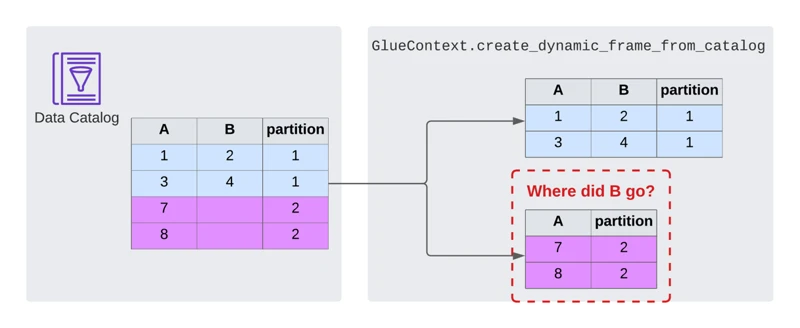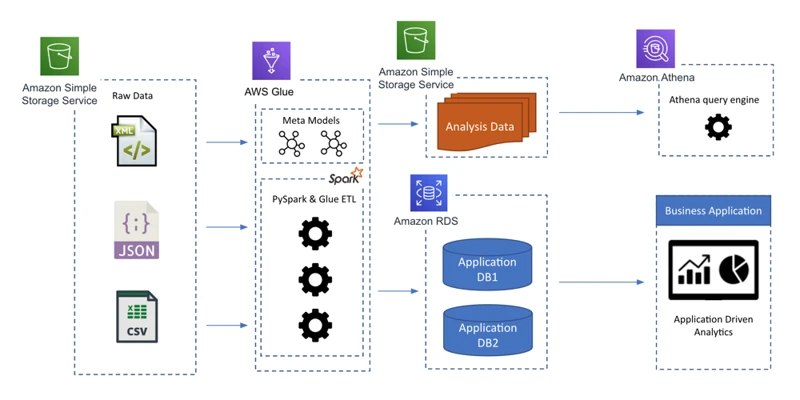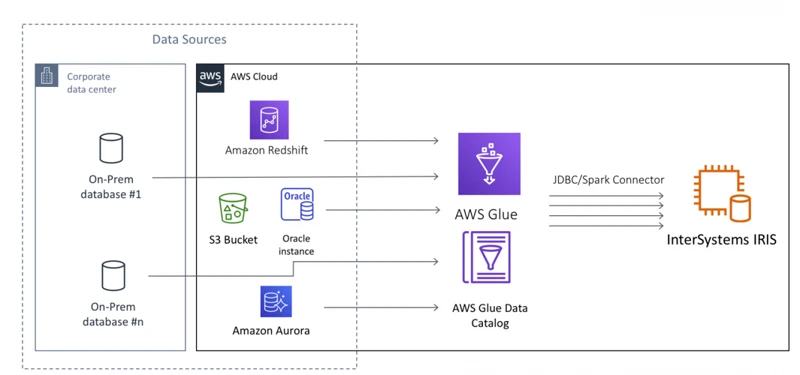Amazon Web Services (AWS) provides a suite of powerful tools designed to simplify the management and analysis of large data sets. Among these tools, AWS Glue stands out for its ability to handle complex data integration tasks. Central to AWS Glue’s capabilities is the AWS Glue Dynamic Frame — a flexible, resilient data structure that allows for easy manipulation and transformation of data. This blog post will delve into what a Glue Dynamic Frame is and how it can be leveraged to optimize data processing tasks.
Understanding DynamicFrame in AWS Glue
At its core, a DynamicFrame is an abstraction provided by AWS Glue, designed to handle semi-structured and unstructured data gracefully. It offers a rich set of API operations for data transformation and processing, supporting various data formats and sources. Unlike traditional data frames that require a rigid schema, Dynamic Frames are schema-flexible, which means that they can accommodate datasets with evolving structures.
Dynamic Frame vs DataFrame: Key Differences
When comparing a DynamicFrame to a traditional DataFrame, a key distinction lies in their approach to schema management. DataFrames necessitate a predefined schema, while Dynamic Frames are more adaptable, handling schema discrepancies on-the-fly. This fluid schema approach enables Dynamic Frames to process data without the need for upfront schema resolution, which can be a significant advantage in ETL processes where the input data may change over time.
Working with AWS Glue DynamicFrame
Utilizing an AWS Glue Dynamic Frame within the Glue ETL jobs involves several steps, from creation to transformation. Developers benefit from the ease with which they can manipulate data, even when dealing with complex or inconsistent schemas.
Creating and Initializing a DynamicFrame
To begin working with Dynamic Frames, one must first create and initialize them within the AWS Glue environment. This can be done by using the AWS Glue API, specifically the awsglue.dynamicframe class, which provides methods for creating Dynamic Frames from various data sources, such as Amazon S3, Amazon RDS, and Amazon Redshift.
DynamicFrame to DataFrame Conversion
Although Dynamic Frames offer greater flexibility, there are scenarios where converting a DynamicFrame to a DataFrame might be necessary, for example, to utilize certain Spark DataFrame operations that are not natively supported by Dynamic Frames. The dynamicframe to dataframe conversion is smoothly handled by AWS Glue, providing a bridge between the two data structures.
Applying Transformations to DynamicFrame
Transforming data is a staple of ETL processes, and with Dynamic Frames, AWS Glue offers a variety of transformation capabilities. These transformations can range from simple mapping and filtering to more complex operations like joins and data type resolution. By employing these transformations, users can shape their data into the desired format for analysis or storage.
AWS Glue DynamicFrame Operations
Dynamic Frames support a diverse array of operations that facilitate efficient data processing. These operations are critical for extracting, transforming, and loading (ETL) tasks within AWS Glue jobs.
DynamicFrame Transformations Examples
Some common aws glue transformations examples include Map, SelectFields, and ResolveChoice. These transformations enable the modification of data within Dynamic Frames, such as altering field names, filtering data, or resolving data type conflicts.
Filtering Data with DynamicFrame Filter
The dynamicframe filter operation is instrumental in refining datasets. It allows users to specify conditions to include or exclude rows from the Dynamic Frame, thus focusing on the relevant subset of data for further processing.
Joining Data with DynamicFrame
Joining disparate datasets is a common requirement in data integration tasks. Dynamic Frames facilitate this by providing the ability to join multiple Dynamic Frames on specified keys, combining data from different sources into a unified structure.
Mapping Functions to DynamicFrame
Applying functions to individual records or a set of fields is made possible through the Map transformation. This operation can be used for a variety of purposes, from simple column renaming to more complex data enrichment and transformation tasks.
Optimizing AWS Glue Jobs with DynamicFrame
Optimization of AWS Glue jobs is crucial for managing resources effectively and ensuring timely data processing. Dynamic Frames contribute to this optimization through their inherent flexibility and the various operations they support.
Repartitioning and Coalescing in DynamicFrame
One strategy for optimizing AWS Glue jobs is to adjust the distribution of data across partitions. Dynamic Frames enable repartitioning and coalescing, which can lead to more efficient data processing by balancing the workload across the available resources.
Handling Schema Evolutions with DynamicFrame
As data evolves, so too must the schemas that define it. Dynamic Frames shine in their ability to manage schema evolution, allowing AWS Glue jobs to adapt to changes in data structure without manual intervention.
Advanced DynamicFrame Techniques
Beyond the basic operations, AWS Glue provides advanced techniques for working with Dynamic Frames that enable fine-tuned data manipulation and transformation.
Resolving Data Types with ResolveChoice
When faced with ambiguous data types, the ResolveChoice transformation comes into play. This technique assists in specifying how to handle fields with mixed data types, ensuring consistency across the dataset.
Flattening Nested Structures with Relationalize
Nested data structures can be complex to work with. However, the Relationalize transformation in Dynamic Frames can flatten these structures into a tabular format, simplifying analysis and data manipulation.
Selecting and Renaming Fields
Selecting specific fields and renaming them for clarity or consistency is a common task in data transformation. Dynamic Frames provide straightforward methods to achieve this, enhancing data readability and usability.
Best Practices for Using AWS Glue DynamicFrame
Adopting best practices when working with AWS Glue Dynamic Frames is essential for building efficient and reliable data processing pipelines. These practices can improve performance and facilitate easier maintenance of AWS Glue jobs.
Improving Performance of Glue Jobs
To enhance the performance of AWS Glue jobs, it is advisable to leverage the capabilities of Dynamic Frames intelligently. This includes selecting the right transformations, optimizing resource allocation, and strategically converting between Dynamic Frames and DataFrames when beneficial.
Error Handling and Debugging
Robust error handling and debugging mechanisms are vital for the success of any ETL process. AWS Glue provides tools and features that aid in monitoring Dynamic Frame operations, allowing for quick identification and resolution of issues that may arise during data processing.
Conclusion
AWS Glue Dynamic Frame represents a powerful tool for handling diverse and evolving datasets within AWS Glue ETL jobs. Its flexibility and rich set of transformations make it an essential component for data engineers and developers working in the AWS ecosystem.
Summary of AWS Glue Dynamic Frame Advantages
The advantages of using a Glue Dynamic Frame include handling schema variability, ease of data transformation, and the ability to optimize AWS Glue jobs for better performance and resource management.
If you’re delving into the practical world of adhesives or exploring the technicalities of AWS Glue, our resources cater to a wide range of interests. For those interested in the bonding capabilities of different adhesives, our article on how strong super glue is on plastic provides great insights. To understand the basics, our piece on what adhesive glue is can be incredibly useful. And for more specific applications, like which glue works best with certain materials, take a look at our guide on what glue sticks to PVC. Meanwhile, if you’re looking into AWS Glue and data integration, our upcoming article on “What Is Dynamic Frame In AWS Glue” will help you navigate through this cloud-based service. Stay tuned!
Future Directions in AWS Glue
As data processing demands continue to grow, AWS Glue and its Dynamic Frame concept are poised to evolve, offering more advanced capabilities and integration options. Staying abreast of these developments will be key for organizations looking to maximize their data processing efficiency and capabilities.




